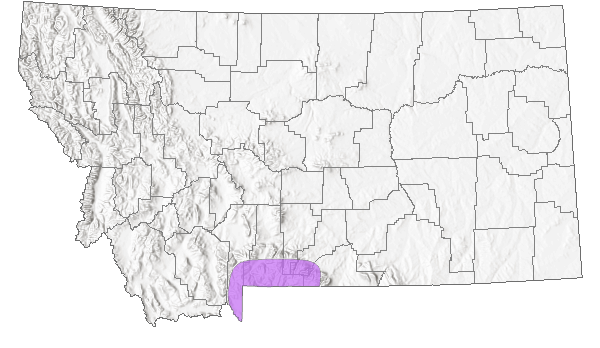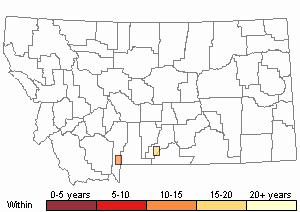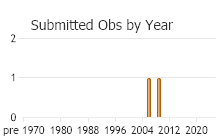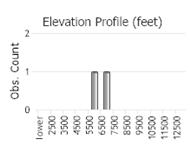View in other NatureServe Network Field Guides
NatureServe
Montana
Utah
Wyoming
Idaho
Wisconsin
British Columbia
South Carolina
Yukon
California
New York
Boreal Top Snail - Zoogenetes harpa
Other Names:
Helix harpa, Acanthinula harpa
General Description
A small shell taller than wide, to 2.5 mm diameter and 3.3 mm in height, conic-ovate, about 4 whorls. The shell is somewhat transparent, grayish-green (live animals may appear darker) and somewhat glossy, with widely spaced lamellar axial ribs and finer incremental striae. Aperture is ovate and oblique, lacking denticles (teeth), lip is not expanded, periphery rounded; the umbilicus is very narrow. Head and foot are gray, tentacles darker, mantle dark gray with lighter spotting (Hendricks 2012, Burke 2013). Internal anatomy is described by Pilsbry (1948).
Diagnostic Characteristics
Unlike any other small (height < 3.5 mm) grayish-green to brownish pupiform shell in Montana. Cone-shape with widely-spaced lamellar axial ribs are unique. Aperture lacks teeth, umbilicus is very narrow.
Species Range
Montana Range
Range Descriptions

 Native
Native
Range Comments
Circumboreal including the northern United States south to Colorado (Burke 2013). In Montana, reported from Gallatin and Stillwater counties, both east of the Continental Divide near the border with Wyoming. Elevations of these sites are 2167 and 1945 m (7110 and 6380 ft), respectively. First reported for Montana in 2006. Range and abundance in Montana remain poorly defined; current status needs investigation. Only single live animals found at sites (Hendricks 2012).
Observations in Montana Natural Heritage Program Database
Number of Observations: 2
(Click on the following maps and charts to see full sized version)
Map Help and Descriptions
Relative Density

Recency



 (Observations spanning multiple months or years are excluded from time charts)
(Observations spanning multiple months or years are excluded from time charts)
Habitat
Moist sites near streams, including campgrounds. Canopy species include Engelmann spruce, subalpine fir and black cottonwood, secondary canopy includes alder. Found under woody debris, in leaf litter, or duff (Forsyth 2004, Hendricks 2012, Burke 2013).
Reproductive Characteristics
Produces living young rather than laying external eggs.
Stewardship Responsibility
References
- Literature Cited AboveLegend:
 View Online Publication
View Online Publication Burke, T. E. 2013. Land snails and slugs of the Pacific Northwest. Corvallis, OR: Oregon State University Press. 344 p.
Burke, T. E. 2013. Land snails and slugs of the Pacific Northwest. Corvallis, OR: Oregon State University Press. 344 p. Forsyth, R.G. 2004. Land snails of British Columbia. Royal British Columbia Museum: Victoria, British Columbia, Canada. 188 pp.
Forsyth, R.G. 2004. Land snails of British Columbia. Royal British Columbia Museum: Victoria, British Columbia, Canada. 188 pp. Hendricks, P. 2012. A Guide to the Land Snails and Slugs of Montana. A report to the U.S. Forest Service - Region 1. Montana Natural Heritage Program, Helena, MT. vii + 187 pp. plus appendices.
Hendricks, P. 2012. A Guide to the Land Snails and Slugs of Montana. A report to the U.S. Forest Service - Region 1. Montana Natural Heritage Program, Helena, MT. vii + 187 pp. plus appendices. Pilsbry, H.A. 1948. Land Mollusca of North America (north of Mexico), Volume II Part 2. The Academy of Natural Sciences of Philadelphia Monograph Number 2(2): 521-1113.
Pilsbry, H.A. 1948. Land Mollusca of North America (north of Mexico), Volume II Part 2. The Academy of Natural Sciences of Philadelphia Monograph Number 2(2): 521-1113.
- Additional ReferencesLegend:
 View Online Publication
View Online Publication
Do you know of a citation we're missing? Beetle, D. E. 1961. Mollusca of the Big Horn Mountains. The Nautilus 74:95-102.
Beetle, D. E. 1961. Mollusca of the Big Horn Mountains. The Nautilus 74:95-102. Beetle, D.E. 1989. Checklist of recent Mollusca of Wyoming, U.S.A. The Great Basin Naturalist 49(4):637-645.
Beetle, D.E. 1989. Checklist of recent Mollusca of Wyoming, U.S.A. The Great Basin Naturalist 49(4):637-645. Henderson, J. 1936. Mollusca of Colorado, Utah, Montana, Idaho, and Wyoming, supplement. University of Colorado Studies 23(2): 81-145.
Henderson, J. 1936. Mollusca of Colorado, Utah, Montana, Idaho, and Wyoming, supplement. University of Colorado Studies 23(2): 81-145. Hendricks, P., B.A. Maxell, S. Lenard, and C. Currier. 2007. Land mollusk surveys on USFS Northern Region lands: 2006. A report to the USDA Forest Service, Northern Region. Montana Natural Heritage Program, Helena, Montana. 11 pp. plus appendices.
Hendricks, P., B.A. Maxell, S. Lenard, and C. Currier. 2007. Land mollusk surveys on USFS Northern Region lands: 2006. A report to the USDA Forest Service, Northern Region. Montana Natural Heritage Program, Helena, Montana. 11 pp. plus appendices.
- Web Search Engines for Articles on "Boreal Top Snail"
- Additional Sources of Information Related to "Snails / Slugs"





